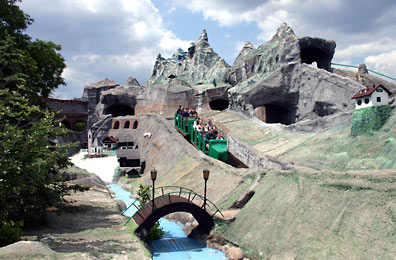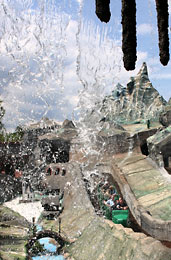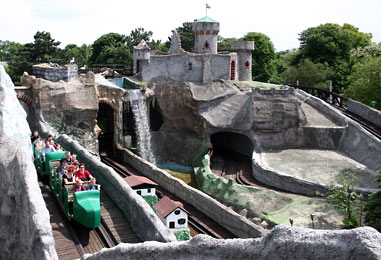 |
|
Nostalgia at the Prater in Vienna |
The end of the 19th century was the first golden era of
roller coasters. Even then people were looking for ever new experiences, and
with technology still being in very early stages, the patrons´ needs had
to be fulfilled in a different way. So roller coaster pioneer La Marcus
Thompson had the idea to run the coaster track within an artificial landscape.
He built such a ride in 1887 in Atlantic City at the US east coast - the
Scenic Railway was born.
In the following decades such rides sprung up like
mushrooms, today their number is shrunk to just nine - with a downward trend
due to high operating and maintenance costs. The youngest Scenic Railway is
called Hochschaubahn and can be found at the Prater in
Vienna.
A characteritic feature of Scenic Railways is, next to the
embedding in an artificial landscape, the brakeman conducting every
train, keeping it safe on track. This is absolutely necessary, since
such rides are side friction roller coasters without upstop wheels
running under the track. Over the decades the brakeman became the most
characteristic "feature" of a Scenic Railway, so even wooden coasters
without any theming are called Scenic Railways if there is a brakeman. De facto
seven of the nine remaining Scenics do not show the landscaped theming. But the
Hochschaubahn in Vienna does: This ride represents the elaborate theming
as it was originally intended.
The Prater has a long tradition, and it has been the
home of several classic wooden coasters and a Scenic Railway. The
old Hochschaubahn by La Marcus A. Thompson from 1909 was combined
with a water ride and was placed next to the ferris wheel, one of
Vienna´s landmarks. But in 1944 it fell victim to a fire that was
caused by an electric malfunction. One year later the complete Prater was
destroyed during an air raid.
  |
|
A ride through an artificial mountain
landscape... |
1948 the innkeeper of today´s Schweizerhaus,
which was only a tent at that time, started to build a new wooden coaster in
his beer garden. But he miscalculated the costs, so a group of investors took
over the activities. Under the supervision of the Kremser,
Moltre, Schneeweiss, Gasselseder and Krista
families the 2.5 million Schilling, about 180.000 Euros, required to finish the
project could be raised. So the Hochschaubahn was opened in February of
1950. In 1971 the Kremser family has acquired 100 percent of the
ride.
The two trains of the coaster consist of two wagons
and carry the brakeman as well as 14 passengers each. After the station,
where the riders are greeted by a number of garden gnomes, the train at first
passes through a twinkling grotto before it reaches the 10 meters high chain
lift at the back of the ride. Here the original motor performs its task -
with an engine power of 14.5 kW, scarcely 20 HP.
After an ample left curve the first drop follows, having a
height difference of almost ten meters. At the bottom the train reaches its
maximum speed of about 40 kilometers per hour - those are no
spectacular numbers for sure, but numbers isn´t what counts here anyway. Important is
the fun experience, and this is - last but not least - accomplished by the
missing restraint system as an extra thrill. The subsequent track leads through
an artificial rock landscape, passing villages and small rivers as well as a
tunnel. Especially on warm summer days some wet surprises produce a short
cooling. The ride ends in a second tunnel before the train slowly glides to the
exit platform. Re-riders can remain seated on the way to the station, doing the
rest of the 450 meters long full circuit.
The Kremser family employs five full time workers and
three seasonal workers who also perform maintenance of the
Hochschaubahn. With their know how they carry out the repair works that
last up to four months each year. Except for some minor technical improvements
the original condition of the ride could be maintained. So for example after
the collapse of the Reichsbrücke in Vienna in 1976 the
coaster was closed by the authorities since they feared that the same
misfortune could happen to the Hochschaubahn. Within just two weeks a
complete second base frame was built, so the construction now has a multiple of
the original stability.
Even though it is the youngest Scenic Railway, the
Hochschaubahn at the Prater in Vienna inheres the charisma
of the waning 19th century, the first golden era of roller coasters.
Besides the enjoyable ride experience the elaborate and affectionate theming
makes it a pleasure for the whole family, whilst for coaster enthusiasts it is
a must do ride not only due to its historical significance. |

